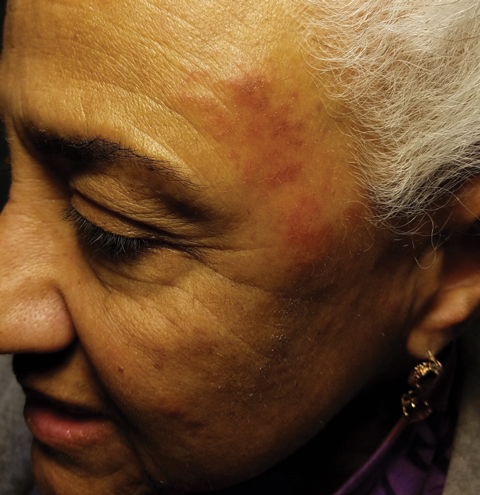 |
Q:
A 71-year-old female underwent cataract surgery and noticed swelling on the first day post-op. She believed she was having an allergic reaction to the prescribed eye drops. The swelling worsened by the following day, and to accompany it, she developed a red irritation on her left scalp. How can we connect the dots to home in on an early diagnosis before things get out of hand?
A:
While it was plausible for the patient to assume the swelling could point to an allergic reaction, it’s the optometrist’s job to ignore red herrings and to be on the lookout for the early signs of other conditions, especially those known to masquerade like herpes zoster ophthalmicus (HZO). Catching it in its prodromal phase can aid in preventing a full-blown outbreak by getting treatment started as soon as possible. It requires a discerning eye and thorough sleuthing.
 |
| Fig. 1. HZO can manifest as a painful red skin irritation that always respects the midline. |
Devil in the Details
“To start, we need to ask more questions,” says Emily Love, OD, of Ophthalmic Consultants of Connecticut. “With any patient over 60 years old, we should ask if she received the Zostavax (Merck) vaccine. Maybe she has a history of cold sores or herpes? Perhaps she remembers experiencing tingling sensations prior to the appearance of the skin lesion?” asks Dr. Love. “It’s also worth asking about other HZO triggers such as any recent exposure to sun, stress, extreme heat or cold or history with alcohol intake.”
Depending on how the patient responds, you can start crossing things off the list. “My differentials list for every patient includes tumor, herpes and fungal infection, and yes, I check them off every single time. Those are the three that will bite you in the butt if you miss them!” says Dr. Love. Here, making an early diagnosis of HZO is the goal. Once it’s full blown, the virus manifests as an extremely painful vesicular rash.
“If, however, the patient is not yet showing HZO’s characteristic presentation, you can continue to narrow your search by checking the patient’s intraocular pressure,” says Dr. Love. If it is in fact HZO, this test will most likely reveal elevation in the eye of the affected side. “Corneal sensitivity could also be decreased, and slit lamp might reveal previous corneal neovascularization, scarring or subepithelial infiltrates,” says Dr. Love.
“Once it’s full-blown, you can’t miss it because HZO always, always respects the midline,” she adds (Fig. 1). “Also, the herpes family manifests through the V1 ophthalmic division of the trigeminal nerve. If, however, the nasociliary nerve is involved, the patient would have a lesion on the end of the nose. That would be your other dead giveaway.”
Table 1. Oral Antiviral Dosage | ||
| Famcyclovir | Acyclovir | Valcyclovir |
| 500mg TID | 800mg 5x/day | 1000mg TID |
The FAV Treatment
Once HZO is unveiled, the patient needs to start antiviral therapy immediately. “I’ve found that my zoster patients with chronic recurrences are okay with taking a pill everyday for prophylactic purposes,” says Dr. Love. She even created a simple mnemonic—“Herpes is my FAV”—to recall the names of the three key drugs: famcyclovir, acyclovir and valacyclovir. “That says it all,” she adds. “Sometimes I’ll even sing that phrase to my patients to lighten the mood, before discussing their treatment plan.”
All joking aside, keep in mind that the road ahead can be rocky. “Don’t forget that post-herpetic neuralgia can be incredibly painful for your patients,” warns Dr. Love. “Recurrences can be common for a lot of folks, so prepare them, educate them and treat them immediately,” she says. With a quick diagnosis and proactive treatment plan, the initial shock can dissipate with ease.

